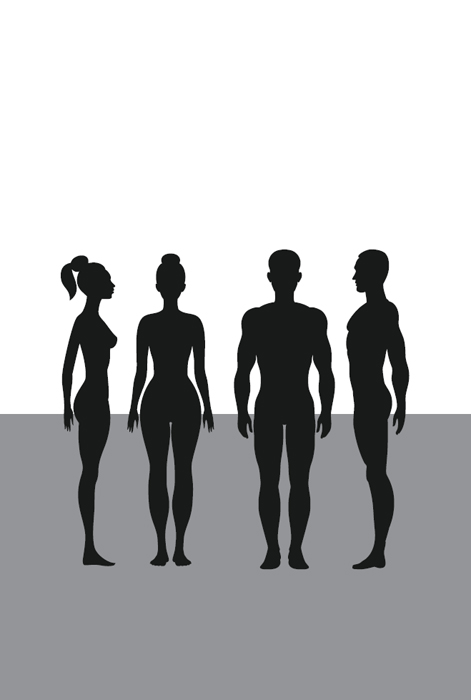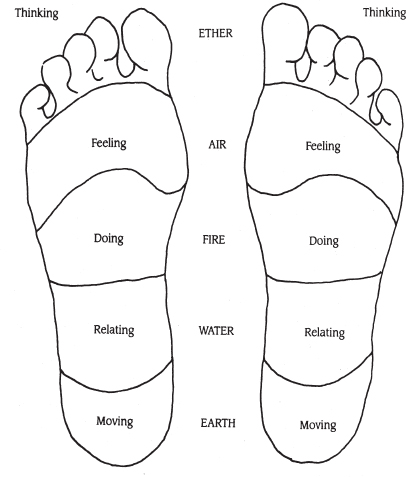

My mother once told me a story about a cobbler who made and mended shoes in a half-basement in a small town in Russia. While he worked on his boots and shoes, he observed the feet and legs that he could see above him, passing by the window, and this set him thinking about the characteristics of people in conjunction with the way they wore out their footwear.
He concluded that exuberant, active and generous personalities wore out their soles beneath the balls of their feet, possibly due to a bouncy walk and a habit of spinning around on one foot. Those who wore out the edges of their shoes on the little toe side were mean-spirited and crabby folk who were frequently also tight-fisted. Those who wore down their heels seemed to be domineering and sometimes not quite in their right minds, while toe scrapers lacked confidence. I leave it to you to look at the undersides of your shoes and to contemplate the characteristics of their wear and tear . . .
Other snippets of folklore suggest that when a woman tucks her foot or leg under her body and sits on it, she is at ease with those she is with, such as family and friends.
Some men or women shake a leg or swing it back and forth rhythmically as a way of releasing unwanted nervous energy.
Bunions grow on those who do a lot for others and not enough for themselves.
A subject whose big toe is longer than his second toe is supposed to be logical, while one whose second toe is longer than his big toe is supposedly intuitive.
The theory of reflexology is that the body is divided up into zones, each of which corresponds to a particular area of the feet. When a reflexologist is asked to help with a particular health problem, he works on the part of the foot that corresponds to the relevant area of the body. Indeed, a skilled reflexologist can often tell what is wrong with his client by the condition of certain parts of the feet.
I remember some years ago, when I was traveling around, working at psychic and alternative health exhibitions up and down the country, spending a hilarious evening sitting up with about five or six friends on a bed in our digs, while Xian (pronounced Shan), a beautiful Chinese reflexologist, gave us an impromptu lecture. She demonstrated her art on our feet, which we lined up on the bed for her inspection. I remember that we all found her tweaking and prodding painful. Indeed, I shall never forget the sight of Malcolm Wright, the palmist, throwing himself across Berenice Watt, the psychic, and howling with a mixture of pain and hysterical laughter while Xian prodded and pulled his toes. Xian's theory was that the foot is like a miniature seated body, whose head is at the tip of the big toe, the bottom is at the heel and the legs and feet extend up the ankle.
I recently met another reflexologist called Gilly Sutherland, a woman just as beautiful as the lovely Xian. Gilly tells me that there are a variety of ideas and methods in use, but they all rely on the idea of zones, and most associate the head with the toes, and work back from there. The system that Gilly uses considers that the area related to the spinal cord runs from the edge of the big toe all the way down the inner side of each foot. The lower areas of the body are associated with the area around the back of the heel, and other soft organs are distributed around the sole of the foot.
In order to give you some idea of how it works without rewriting someone else's reflexology book, here is something that I've known for many years and that I've used to help others from time to time. When someone has a headache, massage the tips and the big pads of the person's toes fairly firmly, without twisting them or hurting them. If the headache is caused by tension, massage the joints on the big toes and the edges of the feet adjoining the little toes.
One final point stressed by most reflexologists is that one should try to keep one's feet healthy and free from corns and calluses, as these cause a blockage or disturbance in the body's natural defense system.
While researching this section of my book, I came across yet another reflexologist named Hazel Goodwin; this woman has worked in the alternative therapy field for many years. Most people these days recognize that one cannot separate the mind, body and spirit, and that a malaise in one area will cross over and affect another. Hazel showed me how a reflexologist can pick up on emotional or spiritual problems while working on the physical ones. Hazel works the feet in order to clear any mental and physical blockages and to restore harmony and well being to the whole person.
The feet can be divided into five lateral zones as shown in the illustration below, each of which is associated with a particular area of the body and at the same time, a particular sphere of the patient's life.

The divisions of the feet
This is associated with the base chakra, the element of earth and the color red. On a physical level, it relates to the lower part of the body, the hips, thighs, legs and feet. On a mental and emotional level, this area refers to movement, so a problem here, either something wrong with the “feel” of the foot or something obvious such as hard skin, may reflect a physical disability preventing the patient from moving around, or a situation that is keeping him or her tied down. One example might be a young woman tied down by small children, while another could be of a person stuck in a job or a relationship that frustrates him. Other possibilities are of wanting to live elsewhere, or to travel more. On another level, the lack of movement can result from trying unsuccessfully to get some enterprise off the ground or trying to shake off lethargy.
This is associated with the sacral chakra, the element of water and the color orange. On a physical level it refers to the abdomen, while on a mental and emotional level, this area refers to relationships. All relationships can be difficult, and a problem here could indicate unhappiness in marriage, troubles between parents and children, problems at work, difficulties with neighbors or even the absence of a relationship.
This is associated with the solar plexus chakra, the element of fire and the color yellow. On a physical level, it rules the middle areas of the body, which are the stomach, thoracic area, liver, pancreas and so on. On a mental level, this area refers to “doing,” so a problem here would show that the patient is having difficulty with the practical side of life. While movement problems may cause temporary or permanent delays, something wrong with the “doing” area shows that the patient isn't doing what he should be doing.
This is associated with the heart chakra, the element of air and the color green. On a physical level, it refers to the heart, lungs and the areas surrounding them. On a mental level, this area refers to the function of feeling. This is a hard one to explain. A person can be too sensitive, both in the physical sense, by over-responding to heat, cold, pain and so on, or on a mental level by becoming upset too easily. Without the sensitivity of “feeling,” we cannot understand the pain of others or notice what is going on around us.
This area is associated with the throat chakra, the element of ether and the color blue. On a physical level, it refers to the area from the top of the shoulders to the top of the head. On a mental level, this area concerns the function of thinking, so it doesn't need much explanation. A clear head and an active brain are always an asset, even when all the other functions are on the blink. To some extent, this area reaches upward even beyond the level of thinking, into the spiritual realms.